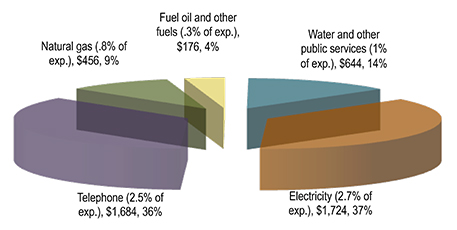October 6, 2014 —  This summer, a 90-year-old water pipe burst under Sunset Boulevard in Los Angeles, sending a geyser 30 feet into the air and a flood of troubles over the UCLA campus. Raging water and mud trapped five people, swamped 1,000 cars and flooded five university buildings — blasting the doors off elevators and ruining the new wooden floor atop the Bruins’ storied basketball court.
This summer, a 90-year-old water pipe burst under Sunset Boulevard in Los Angeles, sending a geyser 30 feet into the air and a flood of troubles over the UCLA campus. Raging water and mud trapped five people, swamped 1,000 cars and flooded five university buildings — blasting the doors off elevators and ruining the new wooden floor atop the Bruins’ storied basketball court.
As the campus dried out, though, Angelenos seemed less upset about the replaceable floorboards at Pauley Pavilion than they were over another loss: 20 million gallons of freshwater wasted in the middle of the worst drought in California history. L.A. Mayor Eric Garcetti took heat for his earlier campaign promise not to raise water rates in a city with a long backlog of repairs for aging water pipes.
Five days after the L.A. pipeline rupture, officials in Toledo, Ohio, declared the tap water for half a million people unsafe to drink, tainted by toxic algae spreading in the warm waters of Lake Erie. As residents of one of the most water-blessed regions in the world waited in lines to buy bottled water, an issue that had held little political urgency rose near the top of Ohio’s gubernatorial and legislative races. Former Toledo mayor Mike Bell held back an “I told you so” for council veterans who’d resisted rate increases to pay for upgrades to the city’s 73-year-old water-treatment plant.
The problems are also laying bare the flawed way we pay for water — one that practically guarantees pipes will burst, farmers will use as much as they can and automatic sprinklers will whir over desiccated aquifers.
In Los Angeles and Toledo and across the U.S., historic drought, water-quality threats heightened by warming waters and poorly maintained infrastructure are converging to draw public attention to the value of fresh, clean water to a degree not seen since Congress passed the Clean Water Act in 1972. The problems are also laying bare the flawed way we pay for water — one that practically guarantees pipes will burst, farmers will use as much as they can and automatic sprinklers will whir over desiccated aquifers.
Squeezed by drought, U.S. consumers and western farmers have begun to pay more for water. But the increases do not come close to addressing the fundamental price paradox in a nation that uses more water than any other in the world while generally paying less for it. And some of the largest water users in the East, including agricultural, energy and mining companies, often pay nothing for water at all.
As a result, we’re subsidizing our most wasteful water use — while neglecting essentials like keeping our water plants and pipes in good repair. “You can get to sustainability,” says David Zetland, a water economist and author of the book Living with Water Scarcity. “But you can’t get there without putting a price on water.”
Cheap, Abundant Illusion
Water is the most essential utility delivered to us each day, meeting our drinking and sanitation needs and many others, from fire protection to irrigation. Incongruously, it is also the resource we value least. This is true generally for both the way we use water and the price we put on it.

Utility expenditures for a four-person household in 2012. Graphic courtesy of Michigan State University Institute of Public Utilities.
On the global scale, Americans pay considerably less for water than people in most other
developed nations. In the U.S., we pay less for water than for all other utilities. That remains true in these times of increasing water stress, says Janice Beecher, director of the Institute of Public Utilities at Michigan State University, whose data show the average four-person household spends about $50 a month for water, compared with closer to $150 for electricity and telephone services.
Water’s historically cheap price has turned the U.S. hydrologic cycle abjectly illogical. Pennies-per-gallon water makes it rational for homeowners to irrigate lawns to shades of Oz even during catastrophic droughts like the one gripping California. On the industrial side, water laws that evolved to protect historic uses rather than the health of rivers and aquifers can give farmers financial incentive to use the most strained water sources for the least sustainable crops. In just one example, farmers near Yuma, Ariz. — the driest spot in the United States, with an average rainfall of 3 inches per year — use Colorado River water to grow thirsty alfalfa; under the law of the river, if they don’t use their allotment, they’ll lose their rights to it.
For both municipal waterworks and those that carry irrigation water to farms, the illusion of cheap, abundant water arose with the extensive federal subsidies of the mid-20th century. The Bureau of Reclamation built tens of billions of dollars worth of irrigation and supply projects that were supposed to have been reimbursed by beneficiaries; most were not repaid. After passage of the Clean Water Act and the Safe Drinking Water Act in the 1970s, the feds doled out billions more dollars, this time to local communities to help upgrade water plants and pipes. Since ratepayers didn’t have to bear the costs, they didn’t balk at treating water destined for toilets and lawns to the highest drinking-water standards in the land.
Americans got used to paying wee little for a whole lot of pristine water. At the same time, many utilities delayed the long-term capital investments needed to maintain their pipes and plants. Water boards are often run by local elected officials, making decisions uneasily political. A board member with a three-year term might not vote for a water project that would pay off in year six. Officials who tried to raise rates risked being booted out of office. It was easier to hope federal subsidies would continue to flow. They did not. A Reagan Administration phase-out of water-infrastructure grants began 25 years ago. Over the past decade, U.S. Environmental Protection Agency water infrastructure funding has declined (with the exception of 2009, the year of the American Recovery and Reinvestment Act), and policy has shifted from grants to loans.
Unfortunately for water utilities, the timing coincided with the arrival of requirements to scrub dozens of newly regulated contaminants out of drinking water and record numbers of water mains and pipes bursting due to age and extreme temperatures, both hot and cold.
Playing Catch-Up
In recent years, municipalities have begun raising rates to play catch-up. Since 2007, city water prices have risen at rates faster than the overall cost of living. Even so, the water sector reports it is not enough to pay for an estimated $1 trillion in anticipated repair costs for buried water pipes and growth-related infrastructure costs over the next 25 years.
When it comes to meeting needs associated with growth, many of the most promising solutions are found on the demand side. Americans still use more water per person than anywhere else in the world. But the U.S. today taps less water overall than it did 40 years ago despite population and economic growth, thanks to increased efficiency and awareness. From irrigation to manufacturing to toilet flushing, everything we do takes a lot less water than it used to.
Everyone is beginning to pay more for water — but communities that conserve have lower long-term costs than those that don’t.
Because utilities’ funding relies on revenue generated by water sales, efficiency has many utilities up a creek and churning blame. Earlier this fall, The Washington Post published a story, reprinted in newspapers around the nation, that blamed “federally mandated low-flow toilets, shower heads and faucets” for water utilities’ financial woes. Conservation, the story said, was the cause of higher water rates and new fees.
The reality is just the opposite, says Mary Ann Dickinson, president and CEO of the Alliance for Water Efficiency, a Chicago-based nonprofit dedicated to sustainable water use. Everyone is beginning to pay more for water — but communities that conserve have lower long-term costs than those that don’t. In many cases, simply saving water can eliminate the need for costly new sources, Dickinson says. Growing, water-stressed cities including San Antonio and Perth, Australia, have saved ratepayers more than a billion dollars in long-term capital costs by helping them slash water use in half. An analysis by the city of Westminster, Colo., found that reduced water use by citizens since 1980 saved residents and businesses 80 percent in tap fees and 91 percent in water rates, compared to the costs of acquiring the new water — close to $220 million on Colorado’s Front Range.
Efficiency will be the answer in many communities, although it cannot save the day in financially strapped cities that are losing population. Detroit’s emergence from bankruptcy depends in part on its ability to sell water, but it has lost a quarter of its population over the past decade. Under pressure to reduce more than $90 million in bad debt, the Water and Sewerage Department in the spring began ordering shutoffs for customers who had fallen behind on their bills, prompting a global outcry and a warning from the United Nations.
Pictures of American families bathing and brushing teeth from five-gallon buckets hold a mirror to the nation’s hydro-illogical cycle: We subsidize water for the largest users in the United States, including agriculture and energy plants, yet we do not ensure a basic amount of water for the poorest citizens.
Agriculture at the Table
Concerns over both quality and quantity make agriculture an increasingly important part of the conversation about how we value and price water.
Likewise, efficiency doesn’t solve water-quality issues like Toledo’s, where ratepayers could be looking at $1 billion for a new drinking-water plant advanced enough to filter out the pollutants brewing in Lake Erie, their water source. Donald Moline, commissioner of Toledo’s public utilities department, says the cost issues are opening up much-needed dialogue with the agricultural community on its contribution to nonpoint-source pollution in Lake Erie. Fueled by farming, septic systems, urban runoff and other causes, nonpoint-source pollution is the largest contributor to water-quality problems in the United States. “It used to be we just weren’t allowed to get into the agricultural causes, but given the science of this, we can’t ignore that piece,” Moline says.
Indeed, concerns over both quality and quantity make agriculture an increasingly important part of the conversation about how we value and price water, says University of Arizona law professor Robert Glennon, author of the books Water Follies and Unquenchable: America’s Water Crisis and What To Do About It.
Irrigation costs differ significantly for American farmers depending on whether they operate in the West or in the East. Reclamation Reform Acts in the 1980s and 90s began to shift the costs of major U.S. irrigation projects — which move river water around the West — from federal taxpayers to western farmers, whose bill depends on an arcane mix of water rights, allocations and contracts. But in the Colorado River basin, century-old water law can still create a tragedy of the commons in which farmers risk losing their allotment if they don’t use it. To solve this waste-encouraging dilemma, Glennon advocates a regulated system of markets and trading that would allow farmers to sell their water allotments to cities in times of drought or let a manufacturer pay to convert a large farm from flood to drip irrigation in exchange for the saved water.
In one hot spot in California’s San Joaquin Valley, U.S. Geological Survey scientists found that steady groundwater pumping in the nut-tree region south of Merced is sinking the ground nearly a foot a year.
Groundwater presents yet another paradox of price: Rising energy costs and declining water levels in troubled aquifers such as the Ogallala in the U.S. Great Plains have helped motivate many farmers to use less water. Agricultural and industrial water users pay for the wells, pumps and energy to draw water up from belowground, but in much of the country they still pay nothing for the water itself — which in some cases has provoked a race to the bottom that can dry up neighbors’ wells and even collapse the ground underfoot. In one hot spot in California’s San Joaquin Valley, U.S. Geological Survey scientists found that steady groundwater pumping in the nut-tree region south of Merced is sinking the ground nearly a foot a year, threatening infrastructure damage to local communities.
In August, the California legislature passed a package of laws to regulate groundwater pumping for the first time in state history. But the laws won’t slow damage to aquifers without meaningful limits on groundwater withdrawals or a charge for extraction, says Zetland, the water economist. Both are tough to pull off in politically regulated systems. Florida has required permits for large groundwater withdrawals since 1972. But governor-appointed water boards are reluctant to deny them, which has aggravated aquifer depletion, drying springs and coastal saltwater intrusion in some parts of the state. For decades, various Florida councils, committees and commissions have concluded that a small fee on groundwater withdrawals — between a penny and 20 cents for every 1,000 gallons — would reduce pumping and fund water-resource protection with “minimal adverse economic impacts” to industry and agriculture, according to one analysis by Chase Securities. But the agricultural lobby keeps the idea from getting very far in the state legislature.
New Approaches
Going forward, water infrastructure, supply and quality challenges intensified by the droughts, floods, temperature extremes and other influences of a changing climate will require new approaches to not only price, but also ethics: using less and polluting less, recycling more, and sharing costs among all users.
At the local utility level, higher prices and tiered price structures, in which households that use more pay more, are both working to encourage conservation. Utilities are also turning to new types of bonds to cover long-term projects, such as the 100-year “green bond” sold this summer by the District of Columbia Water and Sewer Authority to finance environmentally friendly stormwater solutions.
Over the past two decades, drought-addled Australia has built the world’s largest water market, trading $2.5 billion per year and allowing the government to buy back overallocated rights and return water to nature.
Water-science and engineering groups such as the American Society of Civil Engineers make the case that the U.S. infrastructure crisis is severe enough that local communities cannot solve it alone; they suggest that federal investment is crucial to forestall significant costs in emergency repair and business losses.
Market fixes and agricultural partnerships are also part of the answer — especially if water law can evolve to do a better job of protecting the environment and local communities. Over the past two decades, drought-addled Australia has built the world’s largest water market, trading $2.5 billion per year and allowing the government to buy back overallocated rights and return water to nature. Price trends are up — both utility customers and agricultural users are paying more for water — while overall consumption is down. However, feared adverse social impacts may be coming to pass; researchers from Griffith University in Queensland found governments trading “with little regard or knowledge of Indigenous interests, and many Indigenous people believe that contemporary water resource management is amplifying inequities.”
Human rights advocates often oppose water markets on the grounds that we should not commodify an essential human need. But U.S. water use and price have been so skewed for so long that market solutions may be the only politically feasible way to right them. If we are to subsidize anyone, perhaps it should be the poor: A sustenance level of water for those who need it — free or dirt cheap — and higher prices for those who want more and choose to pay. “I argue for a human right to water,” says Glennon. “If we can’t guarantee that in the richest country in the world, we are a sorry lot.”
Key tenets as U.S. water law and policy evolves, Glennon says, are making sure the environment and communities where water originates are not harmed. “It’s glacial, but we are finally seeing people do things differently,” he says. “Across California, you see block rates and municipalities paying people to rip out lawns. Price is going to give us the opportunity to do some things before crisis becomes a catastrophe.”
![]()
Ensia shares solutions-focused stories free of charge through our online magazine and partner media. That means audiences around the world have ready access to stories that can — and do — help them shape a better future. If you value our work, please show your support today.
Yes, I'll support Ensia!

